

[Title]
[text TOC]
[image TOC]
[Site Search]
 [Donation]
[Donation]
 |
Carved Angel |
 |


| Materials |
Tools |
1/4" thick basswood
Template |
Elmer's Craft Bond™ spray glue
Coping or scroll saw
Sharp knife
Emery board
Pencil
Acrylic Paint and brushes
Pushpin
Clothes pin and line
Polyacrylic™ finish |
See the Wood Carving section for more instructions, hints and tips.
This was taught to be by a woodcarving friend, Jean Caster. She calls it a pocket angel. It's relatively easy to carve and with some practice you can turn them out in quantities. The one Jean gave me was numbered #154. You get much better after you have made a few.
It takes about an hour to carve for beginners. Then the sanding and painting takes maybe 30 minutes.
The small size that Jean makes is ideal for carrying in your pocket or purse. I like the larger size for neckerchief or bolo slides and ornaments. The larger size is a little easier to work. For neckerchief or bolo slides, you only have to carve one side, but if you carve both sides, you can choose the best for the front.
Use basswood because it is relatively easy to carve. It can be found at many hobby or wood specialty stores.
It's easiest if you work on a table. If you are afraid of damaging the table then work on a piece of wood at least 6" square.
If you are doing this with a group, do the pre-work and maybe even the setup before hand.
Pre-work
- Make copies of the template in the size that you want.
- Glue the template to the wood using the Elmer's Craft Bond™. The grain of the wood should run the length of the angel. Spray a thin coat of glue on the template, wait three minutes and apply it to the wood. Note: White glue could be used, but you will have to either carve or sand off the paper. If you use Elmer's Craft Bond™ glue, the template will peal off.
- Cut out the template with a saw. If you are doing this with younger children (10 to 14), you want to put in a bit more effort here and cut as close to the outside of the angel as possible. This makes less work for them. For people who are stronger and/or more experienced, you can simply cut out a rectangle.
Setup
- Carve the wood down to the outline on the paper.
- Using the pencil transfer the pattern to the backside.
- Draw a centerline all round the angel using your finger as a stop to aid in spacing it evenly.

Layout
Carve the angel. Repeat these steps for both sides, if desired.
- Make a stop cut on all the interior lines on the front of the angel. Push straight down about 1/16". You may find it easier to move the wood or the knife to follow the curves.
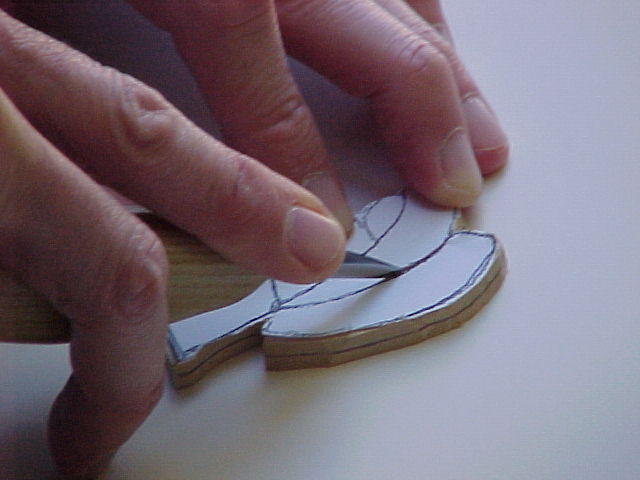
Stop Cuts
- Taper the sides of the wings by holding your knife nearly flat. The blade should enter the wood about 3/4 of the way from the stop cut. Slide your blade along the length of the wing trying to keep the cut the same distance from the line to the outside of the wing and at the same angle. You don't want the wings too thin or they will break.

Wing Cut
- Cut a smaller notch along the bottom side of the line that forms the top of the head.
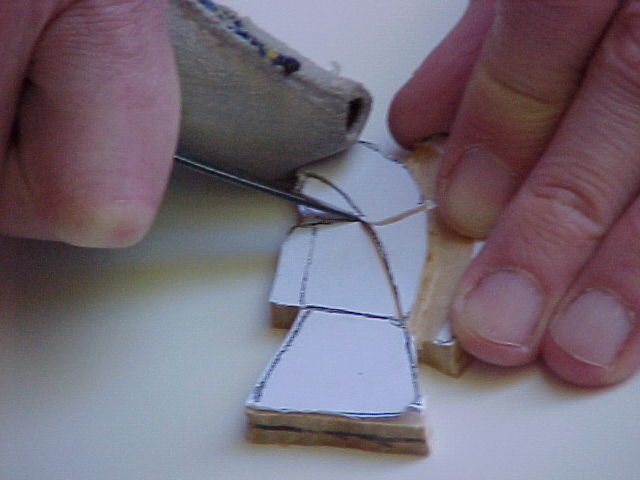
Bottom Notch over Head
- Cut a small notch along the top side of the line that forms the bottom of the head.
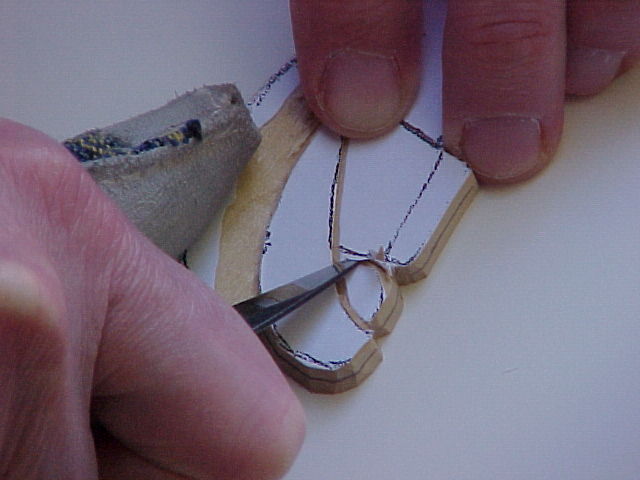
Top Notch under Head
- Cut a wide notch on the bottom side of the waist line.

Waist
- Holding the angel vertical, take a sliver off the side of the arm to indent it.
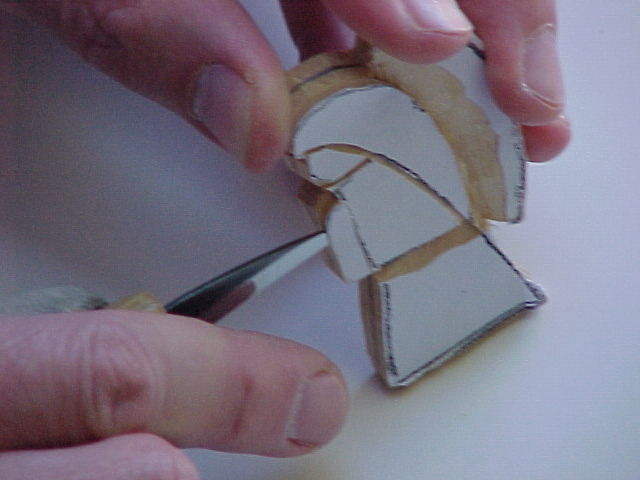
Arm
Final carving
- Cut a small V notch vertically on the front to separate the arms.
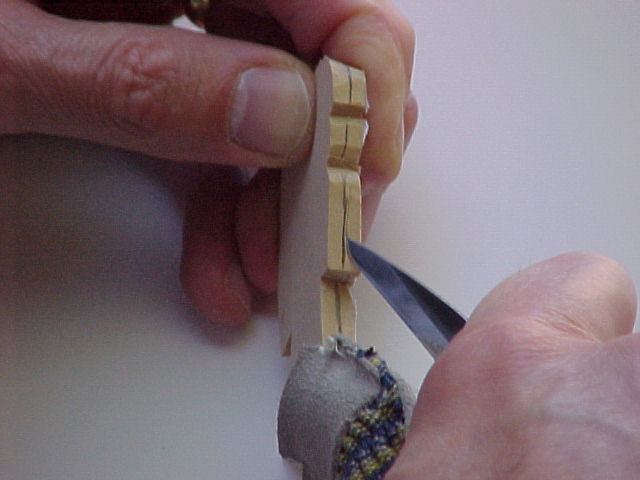
Separate Arms
- Cut a V notch horizontally on the front of the arm to form the hands. Extend this notch on the front and back sides.
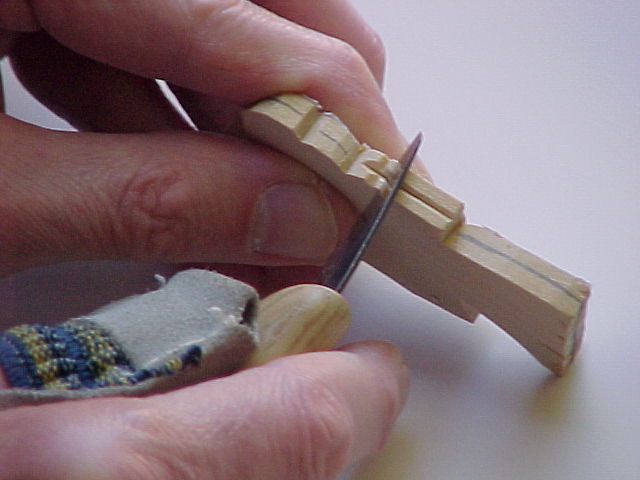
Hands
- Shape the arms a little by making a wide but shallow V notch below the hands.
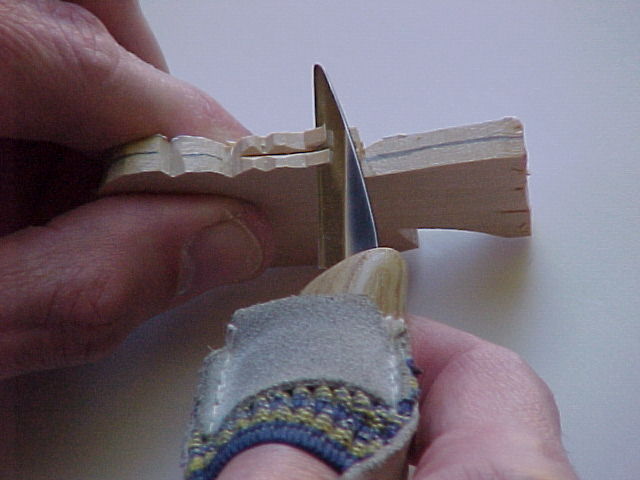
Arms
- Cut a V notch in the back of the wings. To do this first make a cut following the centerline of the wings and then make an angled cut on both sides. You will have to work and re-cut some to get the sliver of wood free. This is probably the most difficult part of making the angel. Take your time and be careful. It's easier to take off too little and have to make another cut than to take off too much and have to glue a piece back on. The top of the wing will be the most difficult because you will be cutting across the grain.
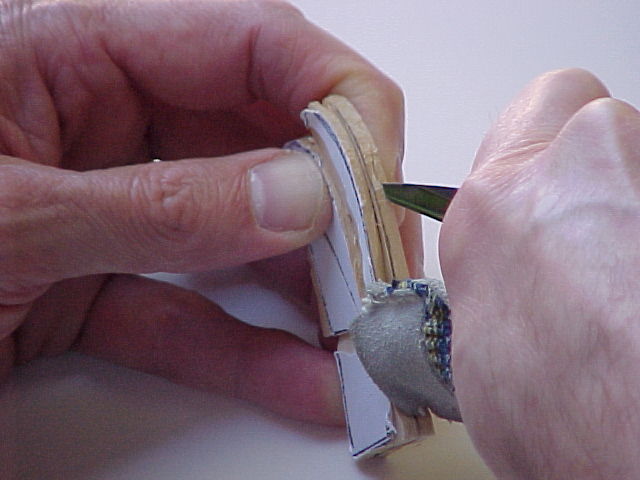
Back of Wings

Your angel should look like this
Finishing touches
- Round off the face.
- Round off the sides of the skirt.
- Peal off the remaining template paper.
- Sand everything smooth and round. Use a piece of sandpaper about 1" wide and 5" long. Fold the end around a Popsicle stick to make a miniature sanding block. Make sure the wings are smooth and the edges are rounded.
- Push a pushpin into the bottom of the angel. Use the pushpin to hold while painting. Put it in a clothespin to stand it on a table or to hang it from a line for drying.
- Clean off any dust. Paint the whole angel white. If acrylic paint is too thick, it tends to make globs. Thin it with a little water.
- Using a very small brush, paint the face and hands. Allow it to dry.
- Sand lightly any rough spots and clean off all dust.
- Put a thin coat of Polyacrylic™ over the whole angel. Don't put too much on or a drip will form and dry on the top of the head of the angel. Hang the angel up to dry. Apply a second coat to make a harder, shinier finish.
You can put your initials, year, and a serial number on the bottom with a fine tip permanent marker.

Copyright © 2005 Vincent Hale

 [Donation]
[Donation]

 [Donation]
[Donation]














